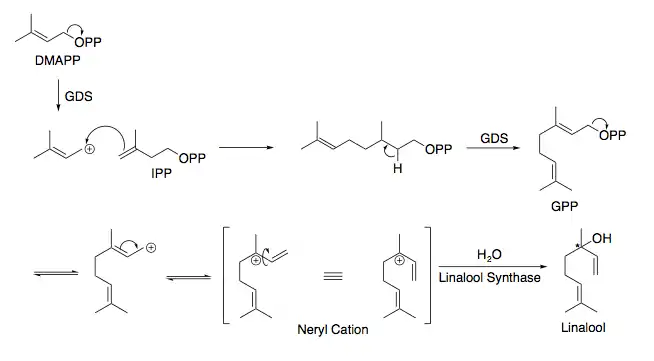Linalool
Linalool (/lɪˈnæloʊɒl, laɪ-, -loʊoʊl, -ˈluːl/) refers to two enantiomers of a naturally occurring terpene alcohol found in many flowers and spice plants.[1] Linalool has multiple commercial applications, the majority of which are based on its pleasant scent (floral, with a touch of spiciness).[2][3] A colorless oil, linalool is classified as an acyclic monoterpenoid.[1] In plants, it is a metabolite, a volatile oil component, an antimicrobial agent, and an aroma compound.[1] Linalool has uses in manufacturing of soaps, fragrances, food additives as flavors, household products, and insecticides.[1] Esters of linalool are referred to as linalyl, e.g. linalyl pyrophosphate, an isomer of geranyl pyrophosphate.[4]
 | |
-Linalool_molecule_ball.png.webp) | |
| Names | |
|---|---|
| Preferred IUPAC name
3,7-Dimethylocta-1,6-dien-3-ol | |
| Other names
3,7-Dimethyl-1,6-octadien-3-ol, β-linalool, linalyl alcohol, linaloyl oxide, allo-ocimenol, coriandrol, Licareol | |
| Identifiers | |
| |
3D model (JSmol) |
|
| 3DMet | |
| ChEBI |
|
| ChEMBL |
|
| ChemSpider | |
| ECHA InfoCard | 100.001.032 |
| KEGG | |
PubChem CID |
|
| UNII |
|
CompTox Dashboard (EPA) |
|
| |
| |
| Properties | |
| C10H18O | |
| Molar mass | 154.253 g·mol−1 |
| Appearance | Colorless oil |
| Density | 0.858 to 0.868 g/cm3 |
| Melting point | < −20 °C (−4 °F; 253 K) |
| Boiling point | 198 to 199 °C (388 to 390 °F; 471 to 472 K) |
| 1.589 g/l | |
| Hazards | |
| NFPA 704 (fire diamond) | |
| Flash point | 55 °C (131 °F; 328 K) |
Except where otherwise noted, data are given for materials in their standard state (at 25 °C [77 °F], 100 kPa).
Infobox references | |
The word linalool is based on linaloe (a type of wood) and the suffix -ol.[5] In food manufacturing, it may be called coriandrol.[1]
Occurrence

Both enantiomeric forms are found in nature: (S)-linalool is found, for example, as a major constituent of the essential oils of coriander (Coriandrum sativum L.), cymbopogon (Cymbopogon martini var. martinii), and sweet orange (Citrus sinensis) flowers. (R)-linalool is present in lavender (Lavandula officinalis), bay laurel (Laurus nobilis), and sweet basil (Ocimum basilicum), among others.
Each enantiomer evokes distinct neural responses in humans, so each is classified as possessing distinct scents. (S)-(+)-Linalool is perceived as sweet, floral, petitgrain-like (odor threshold 7.4 ppb) and the (R)-form as more woody and lavender-like (odor threshold 0.8 ppb).
Over 200 species of plants produce linalool, notably from the families Lamiaceae (mint and other herbs), Lauraceae (laurels, cinnamon, rosewood), and Rutaceae (citrus fruits), but also birch trees and other plants, from tropical to boreal climate zones.
- Lavandula[6]
- Cinnamomum tamala[7]
- Cannabis sativa[8]
- Basil[9]
- Solidago[10]
- Artemisia vulgaris (mugwort)
- Humulus lupulus
It was first synthesized in the laboratory of Leopold Ružička in 1919.[11]
Biosynthesis
In higher plants linalool is formed by rearrangement of geranyl pyrophosphate (GPP).[12] With the aid of linalool synthase (LIS), water attacks to form the chiral center.[13][12] LIS appears to show a limonene synthase-type catalysis through a simplified "metal-cofactor-binding domain [where the majority] of the residues involved in substrate...binding [are] in the C-terminal part of the protein" suggesting stereoselectivity and the reasoning behind why some plants have varying levels of each enantiomer.[14][15]

Odor and flavor
Linalool has complex odor and flavor properties. Its odor is similar to floral, spicy wood, somewhat resembling French lavender plants, bergamot oil or lily of the valley.[1] It has a light, citrus-like flavor, sweet with a spicy tropical accent.[1] Linalool is used as a scent in 60% to 80% of perfumed hygiene products and cleaning agents, including soaps, detergents, shampoos, and lotions.[1][2] It exhibits antimicrobial and antifungal properties.[1][16]
Chemical derivatives
Linalool is hydrogenated to give dihydro- and tetrahydrolinalool, which are fragrances that are more resilient toward oxidants, as might be found in household cleaning products. Linalyl acetate, a popular scent, is produced by esterification of linalool (as well as occurring naturally). Isomerization of linalool gives geraniol and nerol.[17]
Safety and potential toxicity
Linalool can be absorbed by inhalation of its aerosol and by oral intake or skin absorption, potentially causing irritation, pain and allergic reactions.[2][18] Some 7% of people undergoing patch testing in Europe were found to be allergic to the oxidized form of linalool.[19]
The US Food and Drug Administration (FDA) lists linalool in the Code of Federal Regulations under substances generally recognized as safe, synthetic flavoring substances and adjuvants. [20]
See also
References
- "Linalool". PubChem, US National Library of Medicine. 16 October 2021. Retrieved 17 October 2021.
- Eggersdorfer, Manfred (2000). "Terpenes". Ullmann's Encyclopedia of Industrial Chemistry. Weinheim: Wiley-VCH. doi:10.1002/14356007.a26_205.
- Letizia, C.S; Cocchiara, J.; Lalko, J.; Api, A.M (2003). "Fragrance material review on linalool". Food and Chemical Toxicology. 41 (7): 943–964. doi:10.1016/S0278-6915(03)00015-2. PMID 12804650.
- Croteau, R.; Satterwhite, D. M.; Cane, D. E.; Chang, C. C. (1988). "Biosynthesis of Monoterpenes. Enantioselectivity in the Enzymatic Cyclization of (+)- and (-)-Linalyl Pyrophosphate to (+)- and (-)-Pinene and (+)- and (-)-Camphene". The Journal of Biological Chemistry. 263 (21): 10063–71. doi:10.1016/S0021-9258(19)81477-1. PMID 3392006.
- "Linalool". Merriam-Webster.com Dictionary.: "International Scientific Vocabulary, from Mexican Spanish lináloe"
- Kasper S, Gastpar M, Müller WE, Volz HP, Möller HJ, Dienel A, Schläfke S (September 2010). "Silexan, an orally administered Lavandula oil preparation, is effective in the treatment of 'subsyndromal' anxiety disorder: a randomized, double-blind, placebo controlled trial". International Clinical Psychopharmacology. 25 (5): 277–87. doi:10.1097/YIC.0b013e32833b3242. PMID 20512042. S2CID 46290020.
- Ahmed A, Choudhary MI, Farooq A, Demirci B, Demirci F, Can Başer KH (2000). "Essential oil constituents of the spice Cinnamomum tamala (Ham.) Nees & Eberm". Flavour and Fragrance Journal. 15 (6): 388–390. doi:10.1002/1099-1026(200011/12)15:6<388::AID-FFJ928>3.0.CO;2-F.
- Ibrahim EA, Wang M, Radwan MM, Wanas AS, Majumdar CG, Avula B, et al. (March 2019). "Analysis of Terpenes in Cannabis sativa L. Using GC/MS: Method Development, Validation, and Application". Planta Medica. 85 (5): 431–438. doi:10.1055/a-0828-8387. PMID 30646402. S2CID 58668648.
- Klimankova E, Holadová K, Hajšlová J, Čajka T, Poustka J, Koudela M (2008). "Aroma profiles of five basil (Ocimum basilicum L.) cultivars grown under conventional and organic conditions". Food Chemistry. 107 (1): 464–472. doi:10.1016/j.foodchem.2007.07.062.
- Vila R, Mundina M, Tomi F, Furlán R, Zacchino S, Casanova J, Cañigueral S (February 2002). "Composition and antifungal activity of the essential oil of Solidago chilensis". Planta Medica. 68 (2): 164–7. doi:10.1055/s-2002-20253. PMID 11859470. S2CID 260283973.
- Albert Eschenmoser: "Leopold Ruzicka - From the Isoprene Rule to the Question of Life's Origin" CHIMIA 44 (1990)
- Woronuk G, Demissie Z, Rheault M, Mahmoud S (January 2011). "Biosynthesis and therapeutic properties of Lavandula essential oil constituents". Planta Medica. 77 (1): 7–15. doi:10.1055/s-0030-1250136. PMID 20665367.
- Dewick PM (2009). Medicinal Natural Products: A Biosynthetic Approach (3rd ed.). John Wiley & Sons. ISBN 978-0-470-74168-9.
- Cseke L, Dudareva N, Pichersky E (November 1998). "Structure and evolution of linalool synthase". Molecular Biology and Evolution. 15 (11): 1491–8. doi:10.1093/oxfordjournals.molbev.a025876. PMID 12572612.
- Iijima Y, Davidovich-Rikanati R, Fridman E, Gang DR, Bar E, Lewinsohn E, Pichersky E (November 2004). "The biochemical and molecular basis for the divergent patterns in the biosynthesis of terpenes and phenylpropenes in the peltate glands of three cultivars of basil". Plant Physiology. 136 (3): 3724–36. doi:10.1104/pp.104.051318. PMC 527170. PMID 15516500.
- Hussain, Abdullah Ijaz; Anwar, Farooq; Hussain Sherazi, Syed Tufail; Przybylski, Roman (2008). "Chemical composition, antioxidant and antimicrobial activities of basil (Ocimum basilicum) essential oils depends on seasonal variations". Food Chemistry. 108 (3): 986–995. doi:10.1016/j.foodchem.2007.12.010. PMID 26065762.
- Sell, Charles S. (2006). "Terpenoids". Kirk-Othmer Encyclopedia of Chemical Technology. doi:10.1002/0471238961.2005181602120504.a01.pub2. ISBN 0471238961.
- "Linalool". Toxnet, National Library of Medicine, US National Institutes of Health. 14 January 2016. Archived from the original on 28 February 2019. Retrieved 21 May 2019.
- Ung CY, White JM, White IR, Banerjee P, McFadden JP (March 2018). "Patch testing with the European baseline series fragrance markers: a 2016 update". The British Journal of Dermatology. 178 (3): 776–780. doi:10.1111/bjd.15949. PMID 28960261. S2CID 4434234.
- "eCFR :: 21 CFR 182.60 -- Synthetic flavoring substances and adjuvants". eCFR. 2021-10-27. Retrieved 2021-10-29.
